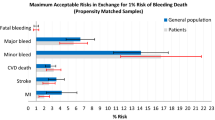Abstract
Strokes can have a catastrophic impact on patients’ health-related quality of life (HRQoL). In addition to warfarin, two novel oral anticoagulants, i.e., dabigatran and rivaroxaban, have been approved to prevent strokes. This study aimed to use direct measures to elicit patient-reported utilities (i.e., preferences) for anticoagulant-related outcomes. A cross-sectional survey was administered to 100 patients taking warfarin in an anticoagulation clinic. Utilities for six long-term and four short-term anticoagulant-related health states were elicited by the visual analogue scale (VAS) and standard gamble (SG) methods. Health states with the highest SG-derived mean utility values were “well on rivaroxaban” (mean ± SD = 0.90 ± 0.15), “well on warfarin” (0.86 ± 0.17), and “well on dabigatran” (0.83 ± 0.18). Approximately half of the patients considered major ischemic stroke (−1.57 ± 6.77) and intracranial hemorrhage (−1.99 ± 6.98) to be worse than death. The percentages of patients who considered a particular health state worse than death ranged from 0 to 55 % among various health states assessed. The VAS had similar findings. Good logical consistency was observed in both VAS- and SG-derived utility values. Ischemic stroke and intracranial hemorrhage had a significant impact on patients’ HRQoL. Greater variation in patients’ preferences was observed for more severely impaired health states, indicating the need for individualized medical decision-making. In this study, both long-term and short-term health states were included in the utility assessment. The findings of this study can be used in cost-utility analysis of future anticoagulation therapies.
Similar content being viewed by others
References
World Health Organization (2008) The top 10 causes of death. http://www.who.int/mediacentre/factsheets/fs310/en/index.html. Accessed 25 July 2013
World Health Organization (2004) The global burden of disease. http://www.who.int/healthinfo/global_burden_disease/2004_report_update/en/index.html. Accessed 25 July 2013
DE Singer, Albers GW, Dalen JE, Go AS, Halperin JL, Manning WJ (2004) Antithrombotic therapy in atrial fibrillation: the Seventh ACCP Conference on Antithrombotic and Thrombolytic Therapy. Chest 126:429S–456S
Sorensen HT, Horvath-Puho E, Pedersen L, Baron JA, Prandoni P (2007) Venous thromboembolism and subsequent hospitalisation due to acute arterial cardiovascular events: a 20-year cohort study. Lancet 370:1773–1779
Ansell J, Hirsh J, Poller L, Bussey H, Jacobson A, Hylek E (2004) The pharmacology and management of the vitamin K antagonists: the Seventh ACCP Conference on Antithrombotic and Thrombolytic Therapy. Chest 126:204S–233S
Baber U, Mastoris I, Mehran R (2014) Balancing ischaemia and bleeding risks with novel oral anticoagulants. Nat Rev Cardiol 11:693–703
Drummond MF (2005) Methods for the economic evaluation of health care programmes, 3rd edn. Oxford University Press, New York
von Neumann J, Morgenstern O (1944) Theory of games and economic behaviour, 1st edn. Princeton University Press, Princeton
Hallan S, Asberg A, Indredavik B, Wideroe TE (1999) Quality of life after cerebrovascular stroke: a systematic study of patients’ preferences for different functional outcomes. J Intern Med 246:309–316
Robinson A, Thomson R, Parkin D, Sudlow M, Eccles M (2001) How patients with atrial fibrillation value different health outcomes: a standard gamble study. J Health Serv Res Policy 6:92–98
Gage BF, Cardinalli AB, Owens DK (1996) The effect of stroke and stroke prophylaxis with aspirin or warfarin on quality of life. Arch Intern Med 156:1829–1836
Froberg DG, Kane RL (1989) Methodology for measuring health-state preferences–I: measurement strategies. J Clin Epidemiol 42:345–354
Furlong W, Feeny D, Torrance GW, Barr R, Horsman J (1990) Guide to design and development of health-state utility instrumentation. The McMaster University. http://www.chepa.org/Files/Working%20Papers/WP%2090-9.pdf. Accessed 3 Jan 2013
Torrance GW (1986) Measurement of health state utilities for economic appraisal: a review. J Health Econ 5:1–30
Brazier J, Ratcliffe J, Salomon JA, Tsuchiya A (2007) Measuring and valuing health benefits for economic evaluation, 1st edn. Oxford University Press, New York
Froberg DG, Kane RL (1989) Methodology for measuring health-state preferences–III: population and context effects. J Clin Epidemiol 42:585–592
Gudex C (1994) Standard gamble user manual: props and self-completion methods. The University of York. http://www.york.ac.uk/media/che/documents/papers/occasionalpapers/CHE%20Occasional%20Paper%2021.pdf. Accessed 3 Jan 2013
Samsa GP, Matchar DB, Goldstein L et al (1998) Utilities for major stroke: results from a survey of preferences among persons at increased risk for stroke. Am Heart J 136:703–713
Read JL, Quinn RJ, Berwick DM, Fineberg HV, Weinstein MC (1984) Preferences for health outcomes. Comparison of assessment methods. Med Decis Making 4:315–329
Shin AY, Porter PJ, Wallace MC, Naglie G (1997) Quality of life of stroke in younger individuals: utility assessment in patients with arteriovenous malformations. Stroke 28:2395–2399
Monz BU, Connolly SJ, Korhonen M et al (2013) Assessing the impact of dabigatran and warfarin on health-related quality of life: results from an RE-LY sub-study. Int J Cardiol 168:2540–2547
Chenaitia H, Lefevre O, Ho V et al (2013) Emergency medical service in the stroke chain of survival. Eur J Emerg Med 20:39–44
El Hachioui H, van de Sandt-Koenderman MW, Dippel DW, Koudstaal PJ, Visch-Brink EG (2011) A 3-year evolution of linguistic disorders in aphasia after stroke. Int J Rehabil Res 34:215–221
Post PN, Stiggelbout AM, Wakker PP (2001) The utility of health states after stroke: a systematic review of the literature. Stroke 32:1425–1429
Acknowledgments
We would like to acknowledge the National University of Singapore for providing us with a research Grant.
Conflict of interest
None.
Author information
Authors and Affiliations
Corresponding author
Electronic supplementary material
Below is the link to the electronic supplementary material.
Rights and permissions
About this article
Cite this article
Wang, Y., Xie, F., Kong, M.C. et al. Patient-reported health preferences of anticoagulant-related outcomes. J Thromb Thrombolysis 40, 268–273 (2015). https://doi.org/10.1007/s11239-015-1191-9
Published:
Issue Date:
DOI: https://doi.org/10.1007/s11239-015-1191-9




